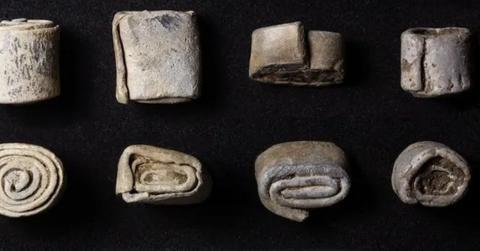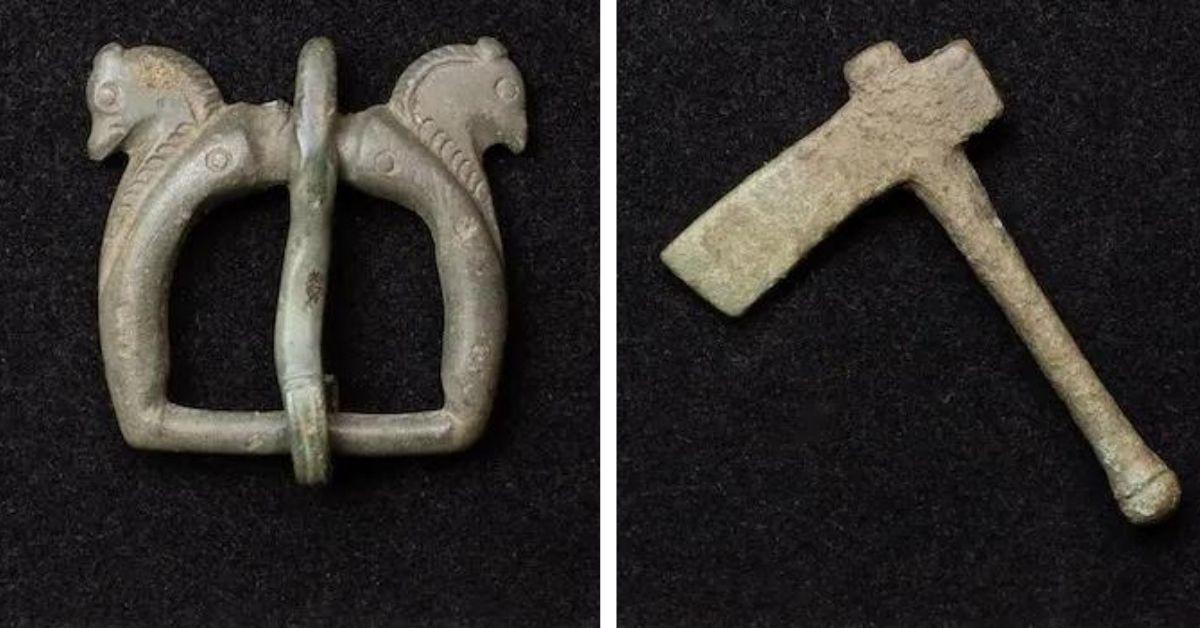Ancient Roman Villa From the Bronze Age Discovered in Britain: Unveiling 'Curse Tablets,' Tiny Axes and Other Artifacts

The tightly coiled lead scrolls believed to be 'curse tablets.'
The remains of ornately decorated Roman buildings were discovered in the village of Grove in Southern England, revealing a variety of artifacts including “curse tablets” and tiny axes.
While the site revealed an ornate Roman villa, archaeologists say the rambling estate was in use as far back as the Bronze Age.
The extraordinary villa uncovered that stood during the Roman period was lavish, complete with painted plaster, mosaics, ornate tile work, colonnades, brick floors and other ornamentations, LiveScience reported, according to a statement from the Red River Archaeology Group (RRAG), which coordinated the excavation.
Among the finds was a collection of tiny, tightly coiled lead scrolls suggesting some sort of ritual.
“They’re little rectangular pieces of lead in which people will write their wishes or curses towards people,” RRAG archaeologist and project officer Francesca Giarelli told McClatchy News.
Afterwards, the scrolls would be rerolled and put in an offering pit, she said.
The archaeologists noted that over time, the entire complex had several aisled buildings with four huge columns that are the largest of their kind from Britain’s Roman era. Alongside the buildings, a “winged corridor” villa was discovered with multiple rooms connected by a central corridor.
The researchers determined that the site, known as Brookside Meadows, was occupied by Romans from the first or second centuries until the late fourth or early fifth century.
They made this determination based on the sheer number of artifacts unearthed that included vast quantities of miniature votive axes, coins and jewelry including rings and brooches, BBC News reported, and that a pilgrimage may have taken place at the site.

A horsehead buckle and tiny axes were among the finds at a Roman villa discovered in the UK.
- What Lies Beneath: NASA Scientist Believes Aliens May Have Found 'Perfect' Hiding Spot in Earth's Oceans
- Global Threat: Russia Insider Warns West of 'World War Using Nuclear Weapons' Amid Escalating Support for Ukraine
- Countdown to Disaster? Ex-NATO Official Warns Russia, Iran and China Could Wage WWIII in Just Years
One of the more interesting discoveries was a horse-headed buckle, dating back to 350-450 AD, and worn by Roman elites. However, RRAG said in a statement that these types of buckles can also be associated with early Anglo-Saxon burials.
"The sheer size of the buildings that still survive and the richness of goods recovered suggest this was a dominant feature in the locality, if not the wider landscape," Louis Stafford, a senior project manager at RRAG, said.
Never miss a story — sign up for the Front Page Detectives newsletter. Be on the scene the moment news breaks.
"The site is far more complex than a regular rural site and clearly was an important center of activities for a long time, from the Bronze Age to the later Roman period," Giarelli added.
She told CNN the villa during the Roman period would have been “central for this area of Oxfordshire.” She described a building that likely had multiple levels. The structure, which stretched across 10,800 square feet on the ground floor alone, was probably visible for miles.
She also noted that villas were not simply residential dwellings but more like “small administrative centers,” during Roman times, and were often responsible for maintaining roads, planning the crops surrounding it and acting as a “safe space” to store food during unstable times.
Archaeologists haven’t yet found “where all the people ended up,” Giarelli told CNN, but they believe there is a burial somewhere on the site, and artifacts, such as the lead scrolls, point to a sanctuary being present, but still hidden underground.
Become a Front Page Detective
Sign up to receive breaking
Front Page Detectives
news and exclusive investigations.
